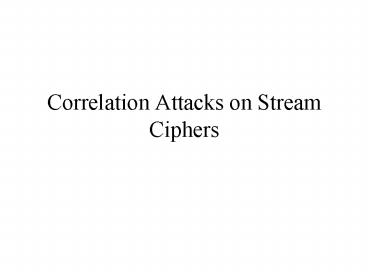Correlation Attacks on Stream Ciphers - PowerPoint PPT Presentation
1 / 25
Title:
Correlation Attacks on Stream Ciphers
Description:
Best Affine Approximation Attack. Correlation Attack by Siegenthaler ... Best Affine Appoximation Attack ... by using an affine approximation of the combination ... – PowerPoint PPT presentation
Number of Views:437
Avg rating:3.0/5.0
Title: Correlation Attacks on Stream Ciphers
1
Correlation Attacks on Stream Ciphers
2
- Linear Feedback Shift Register
- C(D)1c1D...c LDL
- un c1un-1 c2un-2 ... cLun-L , nL,L1
3
- 1 LFSR not secure
- Feedback polynomial known use linear relations
O(L) - Feedback polynomial is unknown use
Berlekamp-Massey algorithm O(L2)
4
- Filter generator
- Combination generator
- ? LFSR has length L? f(L1,...,LM)
5
Attacks on Combination Generator
- Berlekamp-Massey Linearity Synthesis Attack
- Correlation Attack
- Best Affine Approximation Attack
6
Correlation Attack by Siegenthaler
- Known plaintext attack keystream z is known
- Feedback polynomials of LFSRs are known
- Input are i.i.d. random variables
- Correlation between at least one of the LFSRs
output u and the keystream z, - P(zu) ? 1/2
7
Basic idea
- a C(z,u)
- j 0,1...,M
8
Correlation Attack by Meier and Staffelbach
- Idea not all phases of the LFSR are equally
likely. - 2 Algorithms if the number of taps is not too
high - Idea Every digit of u satisfies several linear
relations consisting of t other digits.
Substitute z in these relations.
9
First Algorithm
- Search digits which satisfy the most equations.
- ? estimate of the sequence u at corresponding
positions. - ? Slight modifications of estimation
10
- Complexity of the algorithm is based on the
number of modifications that have to me made - Complexity O(2ck)
- c(t,q,N/L), 0 lt c ? 1
- t ? 10 and q ? 0.75
11
Second Algorithm
- Idea Take all digits together with their prob.
of being correct into account - To each digit of z, we assign a new prob. prob.
that znun conditioned on the number of equations
satisfied. This procedure can be iterated with
the varied new prob. as input to every round. - After few rounds, digits of z whose prob. is
lower than probT are complemented.
12
- Introduction of F(q,t,N/L)
- If F(q,t,N/L) ? 0
- Limite for the attack t ? 10, q ? 0.75
- Complexity O(L)
13
Suggestions
- Any correlation to a LFSR with less than 10 taps
chould be avoided. - There should be no correlation to a LFSR of
length shorter than 100.
14
Correlation attack as decoding problem
- Set of LFSR (length L) sequences is ?
- N keystream digits, set of all truncated
sequences is linear N,L block code - ? LFSR sequence u is regarded as codeword and
keystream sequence z is regarded as output from
BSC.
15
Small improvements
- Find more parity check equations and low weight
parity check equations for feedback polynomials
with low weight. - Golic and Mihaljevic
- Chepyshov and Smeets
- Penzhorn
- Use more powerful iterative decoding methods.
16
Correlation attack based on convolutional codes
- Improvement same performance and low weight
complexity for feedback polynomials of arbitrary
weight. - Idea associate convolutional code with memory B
to code stemming from the LFSR, use Viterbi
algorithm for decoding. - Drawback memory requirements are high
17
Correlation attack based on turbo codes
- Basic Algorithm
- Idea Combination of best parts of previous
algorithms - use of convolutional code
- Use of APP
- General Algorithm
- Idea use M convolutional codes in parallel with
permutation between
18
Algorithm by Canteaut and Trabbia
- Idea Use parity check equations of weight 4 and
5, decode with Gallaghers iterative decoding
algorithm - Complexity slightly badder then algorithms that
use convolutional codes
19
Algorithm by Chepyzhov, Johansson and Smeets
- Idea Associate binary linear n2,k code with
targer LFSR of length L (kltL) and decode this
code. - Complexity better than earlier proposed
algorithms
20
Algorithm based on reconstruction of linear
polynomials
- Idea Correlation attack is modelled as the
problem of learning a binary linear multi-variate
polynomial U(x1,...,xn)u1x1...uLxL - (u1,...,uL) initial state
- N noisy observations z
- Complexity very good in comparison with previous
algorithms
21
Milhaljevic, Fossorier and Imai
- Idea combine exhaustive search over the first B
bits with list decoding algorithm. - Complexity same order as algorithm based on
learning polynomials
22
Chose, Joux and Mitton
- Idea new methods for efficient implementations
- method for finding parity check equations based
on a match-and-sort problem - New decoding algorithm
23
Decimation Attack
- Idea Use d-decimation of the LFSR output
sequence in a correlation attack. If length of
LFSR is prime, the length of this new sequence is
shorter than original LFSR
24
Best Affine Appoximation Attack
- Idea no recovering of the key, just a new
construction of the original generator, by using
an affine approximation of the combination
generator.
25
General Conclusions
- LFSRs
- Boolean function































